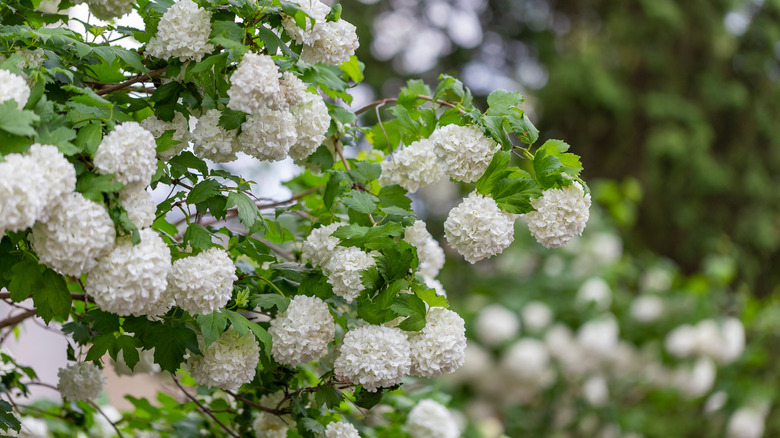How & When To Prune Snowball Viburnum For Marvelous Blooms
The aptly named snowball viburnum is a showstopper when in full bloom, but if you're new to these ornamental shrubs, figuring out when to prune them can be intimidating. Tales of missed blooming seasons and gnarly growing habits keep us on our toes as we worry about all of the mistakes to avoid while pruning. However, once you know a bit more about snowball viburnum blooms and pruning in general, the whole process is a little less scary. What you need to know is that pruning after the shrub is done blooming will get you the best results, as well as selectively choosing the branches to prune rather than indiscriminately chopping off large sections.
To start, it's helpful to know what people mean by "snowball viburnum." Like many common names, this title has been plastered onto a handful of different viburnum species. Usually, however, "snowball" refers to either Viburnum opulus 'Roseum' or Viburnum macrocephalum. The latter is often called Chinese snowball viburnum, while the former goes by several names, including European snowball viburnum. Both are commonly mistaken for hydrangea because of the large pom-poms of white flowers that they produce. Whichever species you end up with, though, how and when to prune is the same.
How to prune your snowball viburnum shrub
Pruning can be an excellent addition to your ornamental shrub maintenance, though it doesn't necessarily need to be done every year. As homeowners, it is really easy to fall into the trap of seeing these sessions as a sort of haircut, lopping off entire sections to control the height or only cutting out the dead pieces. However, selectively pruning branches as part of your maintenance lets you create airflow into the shrub's center to prevent disease or branch rubbing, and staying on top of cutting away disease can prevent its spread. It can also help your shrub produce bigger blooms than it would have otherwise. Selecting flowering branches to trim back allows the plant to put more energy into fewer but bigger blooms rather than multiple small blooms.
To get started, it's important to have sharp, well-maintained pruning tools. Hand pruners are able to cut branches up to an inch thick. Move on to loppers for anything from one to three inches in diameter. It's important to keep tools clean by using a 70% alcohol solution, especially when cutting diseased wood. If you fear you may have a disease issue, clean the blade between cuts to keep it from spreading. Cuts should be made at a 45-degree angle about a quarter-inch above a node, and typically you are not cutting the shrub all the way back to the base. Small cuts to newer wood are the goal for snowball viburnum flowering.
Prune right after blooms fade
To get the most marvelous blooms that you can from your snowball viburnum, the best time to prune is right after they have finished blooming. Like many spring-flowering shrubs, the blooms grow on old wood. In the world of ornamental shrub pruning, the "old wood" is the growth that occurred the year before. So if you decide to prune in fall, winter, or even early spring, you're actually cutting off the dormant buds for that year. That just means that you will miss out on a season of flowers, but there's always next year! However, give your blooms enough time to grow during the summer for the best results.
Another way to avoid the mistake of cutting at the wrong time is to harvest your blooms for arrangements. These fluffy flower balls indeed look great on the branch, like giant popcorn balls in your backyard. But as good as it looks outside, flower farms and florists love to utilize these cut blooms in bouquets and arrangements, and it's an easy way to keep your shrub trimmed back.


